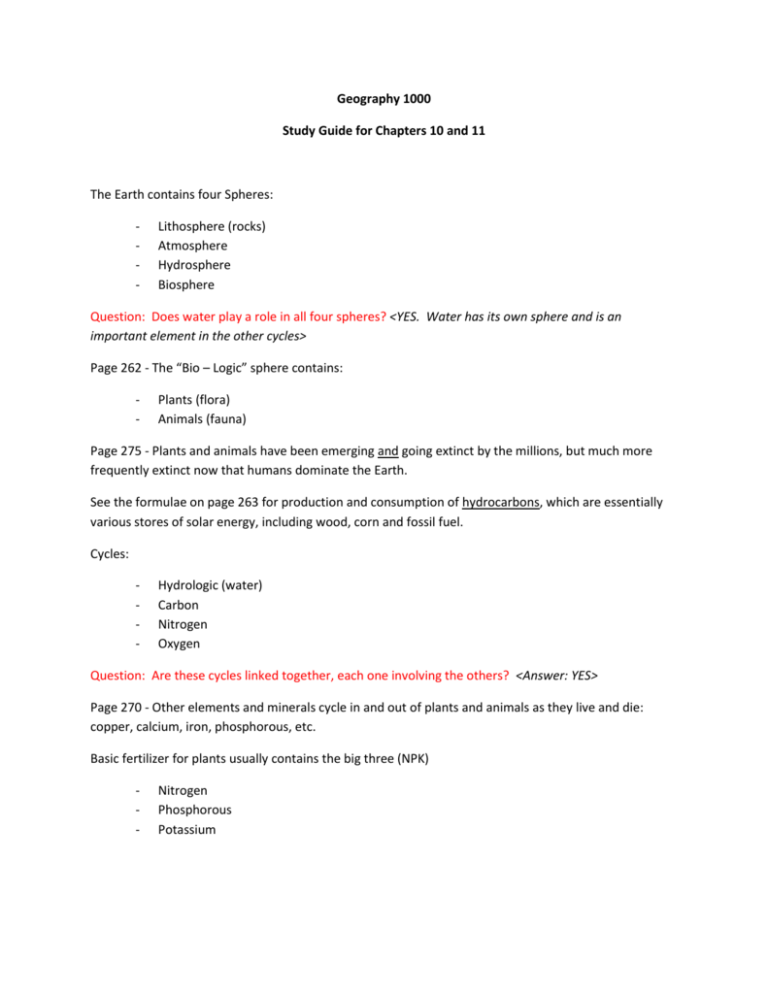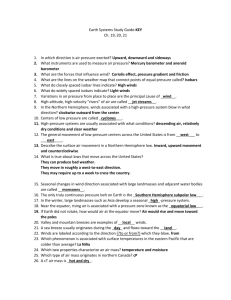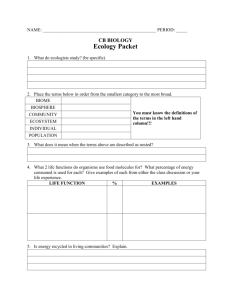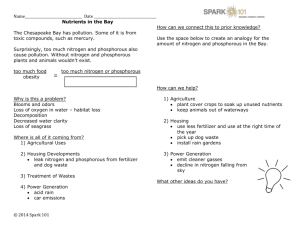Geography 1000 Study Guide for Chapters 10 and 11 The Earth
advertisement

Geography 1000 Study Guide for Chapters 10 and 11 The Earth contains four Spheres: - Lithosphere (rocks) Atmosphere Hydrosphere Biosphere Question: Does water play a role in all four spheres? <YES. Water has its own sphere and is an important element in the other cycles> Page 262 - The “Bio – Logic” sphere contains: - Plants (flora) Animals (fauna) Page 275 - Plants and animals have been emerging and going extinct by the millions, but much more frequently extinct now that humans dominate the Earth. See the formulae on page 263 for production and consumption of hydrocarbons, which are essentially various stores of solar energy, including wood, corn and fossil fuel. Cycles: - Hydrologic (water) Carbon Nitrogen Oxygen Question: Are these cycles linked together, each one involving the others? <Answer: YES> Page 270 - Other elements and minerals cycle in and out of plants and animals as they live and die: copper, calcium, iron, phosphorous, etc. Basic fertilizer for plants usually contains the big three (NPK) - Nitrogen Phosphorous Potassium Question: Nitrogen may be generally inert in the atmosphere, but does it becomes powerful as a fertilizer and as an explosive when energy is invested in creating nitrogen compounds, such as “nitromethane” drag racing fuel? A bag of fertilizer at the store would typically have numbers like: 20-6-8 Twenty percent Nitrogen, six percent Phosphorous and eight percent Potassium Page 270 – poisons can concentrate going up the food chain. Question: Is the “Great Pacific Ocean Garbage Patch” (page 243) a means of concentrating waste and poisons for consumption up the food chain? <Answer: YES> Page 278 – Wildfires are nature’s way of recycling woody and grassy material back into the soil and atmosphere. Question: In what way does nature’s habit of using fire to recycle woody waste work against laws against open burning in Salt Lake valley? <Answer: burning wood recycles the same carbon dioxide over and over, but also puts a lot of aerosols (dust and smoke) in the air> Page 277 – Gradual atmospheric warming in our era means that pine beetles are able to thrive in northern hemisphere forests. The result is growing wildfire hazard as vast quantities of flora (trees) are dying and drying. Question: Is it possible to argue that forest fire prevention works against nature’s habit of recycling dead plants by returning minerals and elements to the soil and atmosphere? <ANSWER: Yes> Nature will tend to recycle them Page 285 – We can summarize world ecosystems into a few key categories: - Tropical forest (Climate zone A) Scrub and Savanna (transition from A to B climate) Dry and Desert (Bk and Bh climates) Mediterranean woodland (C climate, mild continental) Mid-latitude grassland (transition zones between B, C and D climates Mid-latitude forest (D climate zone – cool and humid) Boreal forests to tundra to ice (D to E climate zones) For humans, grasslands are by far the most important climate zones, because various forms of grasses (grains) and similar plants provide food for humans and food for animals that we consume). Page 286 - An ecotone is a transition zone between climates. A primary example includes the expansion of desert expands into grasslands and savanna - - dunes and dry rock taking the place of grasses and trees for supporting animals. At present, the Sahara desert in Africa is encroaching on regions to the south, putting tremendous pressure on millions of people who once depended on grasslands and woodlands. Page 292 – Figure 11-12 illustrates Mr. Allred’s “Handy-Dandy” rules for climate: - As you move away from the Equator, the tree-line goes down. At about the Arctic Circle, trees won’t survive even at sea level and even next to the ocean (water source). Question: At 35 degrees North latitude, the tree line should be at what elevation? <ANSWER: The “curve”in Figure 11-12 suggests a tree line of about 10,000 feet. That is just about right for parts of Utah that range from 35 to 40 degrees north latitude). Page 293 – In the northern hemisphere, the north facing side of slopes should be greener, because of less solar exposure. In the southern hemisphere, the south-facing slope is less exposed to the sun, and thereby should be better able to retain water. Meanwhile, at about 40 degrees north latitude, winds prevail from the west, which means that the west-facing sides of hills should receive most of the available moisture. Question: Taken together, should NW –facing slopes in Utah be the most green, and should SE slopes be the most dry? <ANSWER: Yes> Note: most of the material from pages 294 to 314 is covered in Soils – Chapter 12 Page 315 - Question: Is it true that tropical rain forests are vital for regulation of atmospheric gases, and yet are being consumed by human-caused fires? <ANSWER: Yes> Page 317 – “Slash and burn” agriculture depletes tropical soils that were already weak from too much rain and heat. Rising human population in tropical areas means that poor people tend to try to migrate to places like Europe and the United States. Page 319 – Invasive species include: - Korean Carp (USA) Quaga mussel (Utah) Russian Olive (Western USA) Tamarisk (Utah) Zebra snails (Michigan) Walking Catfish (Florida) “Killer” bees (western hemisphere) Dyer’s wode Cheat grass (western USA) West Nile Virus (USA) Question: Do humans exhibit some of the traits of invasive species?











